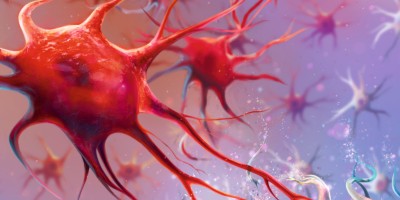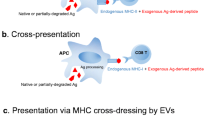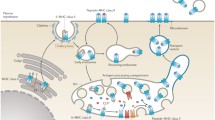Abstract
Soluble extracellular protein antigens are notoriously poor stimulators of CD8+ cytotoxic T-lymphocyte (CTL) responses, largely because these antigens have inefficient access to an endogenous cytosolic pathway of the major histocompatibility complex (MHC) class I–dependent antigen presentation. Here, we present a strategy that facilitates antigen penetration into the cytosol of antigen-presenting cells (APC) by addition to the antigen of charge-modifying peptide sequences. As a result of this intervention, the charge modification enhances antigen uptake into APC by counteracting the repulsive cell surface charge, and then endosomal membranes are disrupted with a subsequent release of antigen into the cytosol. This technology significantly improves MHC class I–dependent antigen presentation to CTL, enabling a more efficient generation of specific CTL immunity in vivo. The strategy described here has potential for use in developing efficient vaccines for antigen-specific immunotherapy of human malignancies.




Similar content being viewed by others
References
Gotch, F., Rothbard, J., Howland, K., Townsend, A. & McMichael, A. Cytotoxic T lymphocytes recognize a fragment of influenza virus matrix protein in association with HLA-A2. Nature 326, 881–882 ( 1987).
Babbitt, B., Allen, P.M., Matsueda, G., Haber, E. & Unanue, E.R. Binding of immunogenic peptides to Ia histocompatibility molecules. Nature 317, 359–361 (1985).
Germain, R.N. The biochemistry and cell biology of antigen presentation by MHC class I and class II molecules. Implications for development of combination vaccines. Ann. NY Acad. Sci. 754, 114–125 (1995).
Heemels, M.T. & Ploegh, H. Generation, translocation, and presentation of MHC class I-restricted peptides. Annu. Rev. Biochem. 64, 463–491 ( 1995).
Cresswell, P. Assembly, transport, and function of MHC class II molecules. Annu. Rev. Immunol. 12, 259–293 (1994).
Braciale, T.J. et al. Antigen presentation pathways to class I and class II MHC-restricted T lymphocytes., Immunol. Rev. 98, 95– 114 (1987).
Nijman, H.W. et al. Antigen capture and major histocompatibility class II compartments of freshly isolated and cultured human blood dendritic cells. J. Exp. Med. 182, 163–174 (1995).
Koch, F. et al. Antigen processing in populations of mature murine dendritic cells is caused by subsets of incompletely matured cells. J. Immunol. 155, 93–100 (1995).
Ridge, J.P., Di Rosa, F. & Matzinger, P. A conditioned dendritic cell can be a temporal bridge between a CD4+ T-helper and a T-killer cell. Nature 393, 474–478 (1998).
Midoux et al. Specific gene transfer mediated by lactosylated poly-L-lysine into hepatoma cells. Nucleic Acids Res. 21, 871–878 (1993).
Plank, C., Oberhauser, B., Mechtler, K., Koch, C. & Wagner, E. The influence of endosome-disruptive peptides on gene transfer using synthetic virus-like gene transfer system . J. Biol. Chem. 269, 12918– 12924 (1994).
Jameson, S.C., Carbone, F.R. & Bevan M.J. Clone-specific T cell receptor antagonists of major histocompatibility complex class I-restricted cytotoxic T cells. J. Exp. Med. 177, 1541–1550 (1993).
Brossart, P., Goldrath, A.W., Butz, E.A., Martin, S. & Bevan, M.J. Virus-mediated delivery of antigenic epitopes into dendritic cells as a means to induce CTL. J. Immunol. 158, 3270–3276 ( 1997).
Akiyama, T., Sudo, C., Ogawara, H., Toyoshima, K. & Yamamoto, T. The product of the human c-erbB-2 gene: a 185-kilodalton glycoprotein with tyrosine kinase activity. Science 232, 1644–1646 ( 1986).
Iezzi, G., Karjalainen, K. & Lanzavecchia, A. The duration of antigenic stimulation determines the fate of naïve and effector T cells. Immunity 8 , 89–95 (1998).
Kim, D.T. et al. Introduction of soluble proteins into the MHC class I pathway by conjugation to an HIV tat peptide. J. Immunol. 159, 1666–1668 (1997).
Greenberg, P.D. Adoptive T cell therapy of tumors: mechanism operative in the recognition and elimination of tumor cells. Adv. Immunol. 49, 281–355 (1991).
Kruisbeek A.M. In Current protocols in immunology, Vol. 1 (eds Coligan, J.E., Kruisbeek, A.M., Margulies, D.H., Shevach, E.M. & Strober, W.) 3.14.1–3.14.11 (Wiley, New York; 1998 ).
Sambrook, J., Fritsch, E.F. & Maniatis, T. Molecular cloning: a laboratory manual. (Cold Spring Harbor Laboratory Press, Cold Spring Harbor, NY; 1989 ).
Czerniecki, B.J. et al. Calcium ionophore treated peripheral blood monocytes and dendritic cells rapidly display characteristics of activated dendritic cells. J. Immunol. 159, 3823–3837 (1997).
Wunderlich, J. & Shearer, G. In Current protocols in immunology, Vol. 1 (eds Coligan, J.E., Kruisbeek, A.M., Margulies, D.H., Shevach, E.M. & Strober, W.) 3.11.1– 3.11.20 (Wiley, New York; 1998).
Acknowledgements
We would like to thank Dr. David Urdal for critically reviewing the manuscript.
Author information
Authors and Affiliations
Corresponding author
Rights and permissions
About this article
Cite this article
Laus, R., Graddis, T., Hakim, I. et al. Enhanced major histocompatibility complex class I-dependent presentation of antigens modified with cationic and fusogenic peptides. Nat Biotechnol 18, 1269–1272 (2000). https://doi.org/10.1038/82377
Received:
Accepted:
Issue Date:
DOI: https://doi.org/10.1038/82377
- Springer Nature America, Inc.
This article is cited by
-
A novel recombinant protein vaccine containing the different E7 proteins of the HPV16, 18, 6, 11 E7 linked to the HIV-1 Tat (47–57) improve cytotoxic immune responses
Biotechnology Letters (2021)
-
Dendritic-cell immunotherapy: from ex vivo loading to in vivo targeting
Nature Reviews Immunology (2007)





